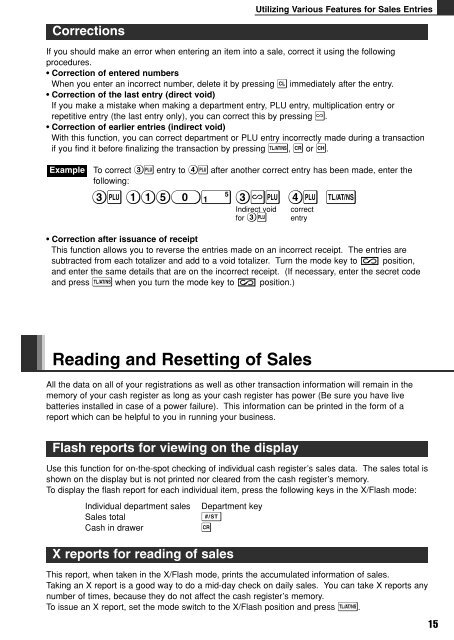XE-A102
XE-A102
XE-A102
Create successful ePaper yourself
Turn your PDF publications into a flip-book with our unique Google optimized e-Paper software.
Corrections<br />
Utilizing Various Features for Sales Entries<br />
If you should make an error when entering an item into a sale, correct it using the following<br />
procedures.<br />
• Correction of entered numbers<br />
When you enter an incorrect number, delete it by pressing c immediately after the entry.<br />
• Correction of the last entry (direct void)<br />
If you make a mistake when making a department entry, PLU entry, multiplication entry or<br />
repetitive entry (the last entry only), you can correct this by pressing v.<br />
• Correction of earlier entries (indirect void)<br />
With this function, you can correct department or PLU entry incorrectly made during a transaction<br />
if you find it before finalizing the transaction by pressing t, R or C.<br />
Example<br />
To correct 3P entry to 4P after another correct entry has been made, enter the<br />
following:<br />
3P 1150! 3vP 4P t<br />
Indirect void correct<br />
for 3P entry<br />
• Correction after issuance of receipt<br />
This function allows you to reverse the entries made on an incorrect receipt. The entries are<br />
subtracted from each totalizer and add to a void totalizer. Turn the mode key to position,<br />
and enter the same details that are on the incorrect receipt. (If necessary, enter the secret code<br />
and press t when you turn the mode key to position.)<br />
Reading and Resetting of Sales<br />
All the data on all of your registrations as well as other transaction information will remain in the<br />
memory of your cash register as long as your cash register has power (Be sure you have live<br />
batteries installed in case of a power failure). This information can be printed in the form of a<br />
report which can be helpful to you in running your business.<br />
Flash reports for viewing on the display<br />
Use this function for on-the-spot checking of individual cash register’s sales data. The sales total is<br />
shown on the display but is not printed nor cleared from the cash register’s memory.<br />
To display the flash report for each individual item, press the following keys in the X/Flash mode:<br />
Individual department sales Department key<br />
Sales total S<br />
Cash in drawer R<br />
X reports for reading of sales<br />
This report, when taken in the X/Flash mode, prints the accumulated information of sales.<br />
Taking an X report is a good way to do a mid-day check on daily sales. You can take X reports any<br />
number of times, because they do not affect the cash register’s memory.<br />
To issue an X report, set the mode switch to the X/Flash position and press t.<br />
15


